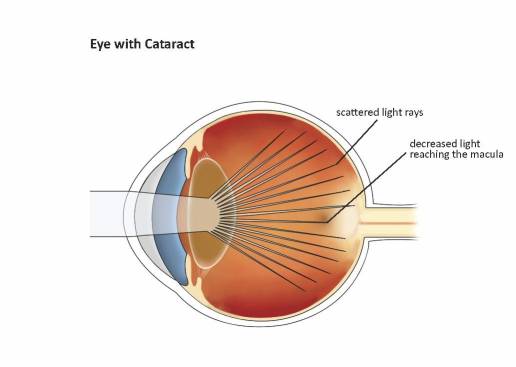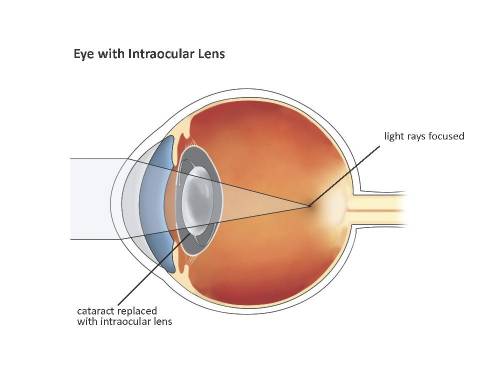Introduction to Intraocular Lenses
Intraocular lenses (IOLs) are used in nearly every cataract surgery performed.They are placed inside your eye after your cataract is removed, and they replace the lost focusing power of your native crystalline lens after cataract surgery. Without an IOL you would be unable to see clearly. In decades past, IOLswere able to correct for near- and far-sightedness, but not for presbyopia and astigmatism. Today, there are multiple types of IOLs available that can correct not only for near- and far-sightedness, but also for presbyopia and astigmatism. These newer generation specialty lenses available today are referred to as “new-technology”, “advanced-technology”, “presbyopia-correcting”, “astigmatism-correcting”, or “premium” IOLs. Traditional or conventional IOLs that were originally developed are called “monofocal” IOLs.
It is important to understand the differences between these lenses so you can make an educated decision when you are selecting your IOL. You will want to consider how monofocal and premium lenses would work for you in your daily routine. You will also need to have an in depth discussion with your eye surgeon about these lenses, as not all patients are candidates for presbyopia- or astigmatism-correcting IOLs. Patients who are not appropriate candidates for premium IOLs will have a conventional monofocal IOL placed in their eye after cataract removal.
Reducing Dependence on Glasses and Premium IOLs
Premium IOLs have revolutionized the treatment of cataract surgery, and have allowed patients to achieve greater glasses independence after cataract removal by correcting for presbyopia and astigmatism, as well as distance vision. What that means is that patients who receive these lenses typically require glasses for fewer activities and tasks than patients who receive conventional monofocal IOLs. Using these lenses does not guarantee that you will be completely free of glasses, but chances are good that you will be much less dependent on them after cataract surgery than you would be with a monofocal IOL. These lenses are not covered by insurance companies, so there is an additional out-of-pocket cost to patients who choose these lenses.
There are two classes of presbyopia-correcting IOLs. They are multifocal IOLs and accommodating IOLs. Patients can achieve good vision after cataract removal with monofocal, multifocal, accommodating and astigmatism-correcting (toric) IOLs. The main difference between the effects of these IOLs is the clarity of your vision without glasses, and how often you will need to wear glasses after your cataract surgery. Only you can decide if glasses independence is important to you, and only your eye surgeon can determine if the use of a premium lens is appropriate for your eye.
How Your IOL Affects Light As It Enters the Eye
A cataract causes light to scatter before it reaches the retina, which directly leads to a reduction in vision. Your new IOL will cause light to focus again. It will not always focus light directly on the retina, but because the light rays are focused, the point of focus can be moved to the retina with glasses or contact lenses to give you clear vision. The closer the point of light focus is to the retina, the smaller the glasses prescription will be. So if the point of focus is far from the retina, the glasses prescription will be large. If the point of focus is close to the retina, the glasses prescription will be small. The following drawings help illustrate this process.
Illustration demonstrating the scattering of light that occurs as a result of cataract formation.
Illustration demonstrating how clear intraocular lenses cause light to focus precisely following cataract removal.
If you are interested in having a premium IOL, it is important that you have an in-depth discussion with your surgeon in order to determine which lens is best for you. You will need to think about when it would be most important for you to have good vision without glasses. What activities do you perform, and which of those activities would you like to perform without glasses? Alternatively, when would you be least bothered if you needed glasses for clear vision? You will also want to consider the possible side effects of these lenses. Is this a trade-off you are willing to make for improved uncorrected vision and increased glasses independence? In addition, you will want to let your surgeon know what your specific post-surgery goals and expectations are to make sure they are in line with what these lenses can provide for you. Together, you and your surgeon can determine which lens is best for you.
Both multifocal and accommodating IOLs enjoy higher success rates when they are placed in both eyes. In other words, if you have a multifocal lens in one eye and a monofocal lens in the other, you are less likely to achieve glasses independence. This also means it is important not to get discouraged if you have had surgery only in one eye and are not happy with your vision. In most cases, your vision will improve after your second eye surgery is completed.
These lenses also work best if the distance prescription is minimal after surgery is completed, which allows you to achieve the maximum benefit from your IOL. Unfortunately, it is not possible to exactly predict one’s postoperative vision or refraction. Mathematical prediction formulas are used to determine what strength (power) of IOL to place in the eye after cataract removal. With the technology and formulas in use today, estimates can be fairly accurate, but you may still be slightly under- or over-corrected in relation to your target. If this occurs, there are a few ways to improve your uncorrected vision that will allow you to get the most out of your premium IOL. These options are discussed in “Other Ways to Reduce Dependence on Glasses.” Most of these options can be used in conjunction with a monofocal IOL, as well.
In summary, there are now four categories of IOLs available to patients today. They are monofocal, multifocal, accommodating and astigmatism-correcting (toric) IOLs. Please see the appropriate page for in depth discussion of each of these types of lenses.
© Vision Information Services, LLC, Mooresville, NC 2012

